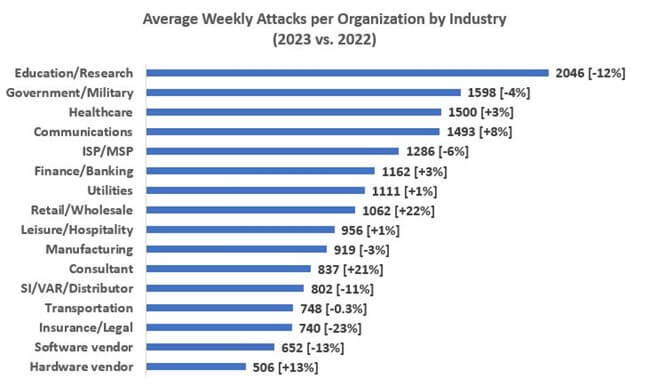
In 2023, the world faced an unprecedented surge in cyber threats, a storm that Check Point Research’s analysis has vividly captured. The year marked a new high in cyber attacks, with a 1% increase from the previous year, reaching an average of 1158 weekly attacks per organization globally.
In this evolving battlefield, ransomware remained a formidable foe, but with a twist. Attackers shifted their focus from traditional encryption-based tactics to more insidious extortion-based campaigns. The MOVEit and GoAnywhere incidents stand as harrowing examples of this shift, where attackers demanded ransoms not for decryption keys, but for the silence over stolen data.
2023 saw the Retail/Wholesale sectors becoming prime targets, likely due to their vast reservoirs of consumer data and digitalized operations. Their intricate supply chain networks and high transaction volumes also contributed to their vulnerability, making them attractive targets for cybercriminals.

The Asia-Pacific region led in weekly cyber attacks, followed closely by Africa, indicating a significant geographical variation in the threat landscape.
This year witnessed the alarming rise of mega ransomware attacks, characterized by their extensive scale and impact. Zero-day exploits played a crucial role, amplifying the damage and the number of victims. This new breed of ransomware attacks highlighted a strategic pivot in cybercrime – from disrupting operations to monetizing stolen data through extortion.
An all-time peak in ransomware attacks was recorded in 2023, with 10% of organizations globally targeted. The Americas experienced the most significant year-over-year increase in such attacks.
Education/Research, Government/Military, and Healthcare sectors were the top victims of ransomware attacks, emphasizing the need for heightened security measures in these critical industries.
In response to these escalating threats, AI has emerged as a powerful ally in cybersecurity. Check Point’s ThreatCloud AI exemplifies this, using AI and big data to prevent attacks and reduce false positives. This advanced system demonstrates the potential of AI in real-time threat detection and prevention, underscoring its importance in the fight against cybercrime.
The landscape of cyber threats in 2023 serves as a stark reminder of the ever-evolving nature of cyber attacks. The rise of mega ransomware attacks, the shift in attacker tactics, and the increasing sophistication of threats underscore the need for robust cybersecurity measures. As cybercriminals continue to adapt and evolve, so must our defenses. The integration of AI in cybersecurity strategies offers a promising path forward, but it requires a collective effort from organizations, governments, and individuals to turn the tide in this ongoing battle.